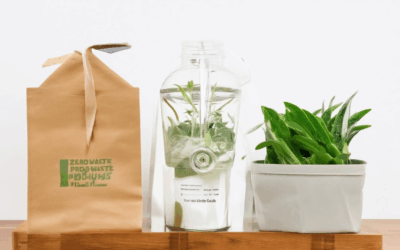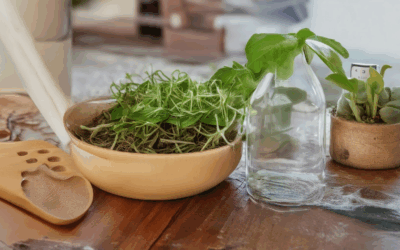Reducing waste and embracing a sustainable lifestyle has never been more important than now, especially when it comes to raising a family. In today’s world, single-use plastics seem to surround us, from packaging to everyday items, leaving a lasting impact on our environment. For parents seeking a cleaner, greener way of life, plastic-free parenting offers a transformative approach to creating a healthier home and a more sustainable future. By adopting a plastic-free parenting plan, families can take meaningful steps toward minimizing their ecological footprint while fostering a sense of responsibility in their children. This guide will walk you through the essential steps, tools, and strategies to begin your own plastic-free journey, providing practical solutions and actionable tips to reduce waste and live a more mindful lifestyle. Whether you’re just starting out or looking to refine your current efforts, discover how plastic-free parenting can empower your family to thrive in harmony with nature.
Key Takeaways
- Adopt Plastic-Free Habits: Minimize single-use plastics by using reusable items like water bottles, cloth napkins, and eco-friendly lunch boxes.
- Choose Eco-Friendly Alternatives: Opt for biodegradable and compostable products, supporting sustainable materials and practices.
- Reduce Disposable Diaper Use: Transition to cloth diapers or sustainable options to decrease plastic waste.
- Cut Down on Food Packaging: Bring reusable containers to stores and explore local markets for bulk purchases.
- Invest in Reusable Products: Prioritize durable, high-quality items that reduce waste over time.
- Clean Safely with Nature: Use natural cleaning solutions like vinegar, baking soda, and essential oils for a healthier and eco-friendly home.
- Support Sustainable Brands: Align with trusted brands that promote eco-conscious values and practices.
- Foster Environmental Awareness: Teach children about plastic pollution and involve them in eco-friendly activities to build a sustainable mindset.
- Create a Structured Approach: Start by assessing plastic use, then gradually switch to eco-friendly products and involve the family in the process.
- Embrace a Plastic-Free Lifestyle: Through education, smart shopping, and natural cleaning, lead by example and inspire your family to adopt sustainable habits.
- Celebrate Progress: Acknowledge and reward small changes to maintain motivation and encourage continued efforts towards a greener lifestyle.

How to Begin a Plastic-Free Parenting Plan
Reducing plastic use in your household can be a meaningful project for you and your children. Here’s a structured approach to help you get started:
1. Assess Current Plastic Usage
Start by identifying areas where plastic is frequently used. Common culprits include single-use items like water bottles, snack wrappers, and packaging. Look for opportunities to replace these with eco-friendly alternatives.
2. Reduce Single-Use Plastics
- Bottled Water: Opt for reusable bottles.
- Snacks: Use reusable cloth bags or metal containers.
- Toys and Educational Materials: Consider wooden toys or books.
3. Choose Eco-Friendly Products
- School Supplies: Invest in reusable items like cloth lunch bags.
- Food Storage: Use glass containers or beeswax wraps instead of plastic wrap.
- Cleaning Products: Select biodegradable and plastic-free options.
4. Opt for Sustainable Clothing
- Fabric Choice: Encourage natural fibers like cotton and hemp.
- Second-Hand Clothing: Teach kids to appreciate and care for used items.
- Repair Clothes: Extend clothing life through mending and alterations.
5. Minimize Microplastics
- Synthetic Fabrics: Avoid contributing to microplastic pollution by choosing natural fabrics.
- Toiletries: Switch to refillable or recyclable packaging products.
6. Involve Kids in the Process
- Education: Explain the environmental impact of plastic to foster awareness.
- Family Challenges: Engage everyone in activities like a “Plastic-Free Week.”
- DIY Projects: Involve kids in creating eco-friendly products.
7. Utilize Resources and Tools
- Eco-Friendly Guides: Explore tips and resources from trusted platforms like Eco Planeta Verde .
- Zero Waste Stores: Find local shops offering plastic-free essentials.
8. Set Realistic Goals
- Start Small: Implement gradual changes to avoid overwhelm.
- Celebrate Progress: Acknowledge and reward efforts to encourage continued participation.
By taking these steps, you can create a plastic-free lifestyle that educates and inspires your family. Remember, every small change contributes to a healthier planet for future generations.
Creating a Plastic-Free Parenting Plan
To create a plastic-free parenting plan, follow these organized steps to reduce plastic use in your household while educating your children about sustainability:
- Assess Current Habits: Begin by identifying areas where plastic is frequently used, such as kitchen, bathroom, and toy storage. List specific plastic items like bottles, wrappers, and toys.
- Find Alternatives: Replace plastic items with eco-friendly options. Use glass jars for snacks, stainless steel bottles for drinks, and biodegradable soap bars in the bathroom. Consider products from Eco Planeta Verde for recommendations.
- Shop Mindfully: Choose products with minimal packaging. Look for items in cardboard or paper packaging. Explore local stores or online shops that specialize in sustainable products, such as those listed on Eco Planeta Verde’s store locator .
- Involve Children: Teach kids about plastic pollution and its environmental impact. Use educational resources like books or videos to explain the effects. Involve them in selecting eco-friendly products and projects to foster engagement.
- Reduce Disposable Plastics: Bring reusable items to restaurants. Explore biodegradable utensils from recommended brands, possibly found on Eco Planeta Verde’s brand directory .
- Sustainable Cleaning Products: Transition to eco-friendly cleaning supplies. Look for bulk options or refillable containers. Check Eco Planeta Verde’s cleaning product guides for suitable alternatives.
- Ethical Clothing Choices: Opt for organic cotton or recycled fabrics. Visit Eco Planeta Verde’s sustainable fashion section for ethical clothing options.
- Recycling and Disposal: Set up proper recycling and composting systems. Check local programs for plastic waste management and consider home composting for biodegradable waste.
- Gradual Changes and Challenges: Implement small, weekly changes to reduce plastic use. Create a “plastic-free week” challenge to stay motivated and track progress.
- Cost Considerations: Seek affordable alternatives and utilize sales or discounts. Explore local store promotions or eco discounts for budget-friendly options.
- Share and Inspire: Discuss your journey with friends and family. Start a support group to share tips and inspire others towards a plastic-free lifestyle.
By methodically addressing each area and involving your family, you can successfully create a plastic-free parenting plan, setting a positive example for sustainable living.

How to Start a Plastic-Free Parenting Lifestyle
Elevate your parenting journey by embracing a plastic-free lifestyle. This approach not only reduces exposure to harmful plastics but also fosters a more sustainable environment for your children. Here’s how to begin:
- Reduce Single-Use Plastics: Minimize reliance on items like disposable bottles, wrappers, and packaging. Invest in reusable alternatives like stainless steel sippy cups and cloth napkins.
- Choose Non-Toxic Products: Opt for natural, chemical-free baby products. Look for options made from organic materials and free from harmful additives.
- Certified Sustainable Products: Prioritize products certified by organizations like USDA Organic or Fair Trade. These labels ensure lower chemical use and ethical practices.
- Support Ethical Brands: Partner with companies committed to reducing plastic use. Many brands now offer biodegradable and eco-friendly baby goods.
- DIY Solutions: Create your own cleaning and care products using natural ingredients. This reduces plastic waste and exposure to harsh chemicals.
By incorporating these changes, you can create a healthier and more environmentally conscious home for your family. Remember, every small step contributes to a bigger impact!
Eco Planeta Verde offers comprehensive guides and resources to help you transition to a plastic-free lifestyle. Explore our blog for inspiration and practical tips to make sustainable living easier than ever.
Learn more about sustainable living

Effective Strategies for Plastic-Free Parenting
Eco Planeta Verde believes in embracing a sustainable lifestyle, especially when it comes to raising the next generation. Here are some practical strategies to help reduce plastic use in daily routines:
- Reduce Single-Use Plastics: Minimize plastic bottles, wrappers, and disposable items. Invest in reusable water bottles, cloth napkins, and eco-friendly lunch boxes.
- Choose Eco-Friendly Alternatives: Opt for biodegradable and compostable products. Look for options made from recycled materials or sustainably sourced ingredients.
- Ditch Disposable Diapers: Consider switching to cloth diapers or disposable ones made from sustainable fabrics. Many brands now offer eco-conscious options.
- Minimize Food Packaging: Bring your own containers to grocery stores or markets. Support local farmers’ markets where you can buy in bulk or bring your own containers for filling.
- Use Reusable Products: From shopping bags to baby bottles, invest in high-quality, durable items that last longer and reduce waste.
- Clean with Natural Products: Make your own cleaning solutions using vinegar, baking soda, and essential oils. These are safe for the environment and your family.
- Support Sustainable Brands: Eco Planeta Verde partners with trusted brands like these to bring you products that align with your values.
Mindset Shifts for Plastic-Free Parenting
Adopting a plastic-free lifestyle isn’t just about changing habits—it’s about fostering a deeper connection with your surroundings. By teaching your children to care for the planet, you’re setting them up to make environmentally responsible decisions in the future.
Eco Planeta Verde encourages families to take small, consistent steps toward sustainability. Whether it’s reducing plastic at home or exploring new eco-friendly hobbies, every effort counts. Visit our Plastic-Free Living Guide for more tips and resources.
How to Begin a Plastic-Free Parenting Plan
Reducing plastic use in your household can be a meaningful project for you and your children. Here’s a structured approach to help you get started:
1. Assess Current Plastic Usage
Start by identifying areas where plastic is frequently used. Common culprits include single-use items like water bottles, snack wrappers, and packaging. Look for opportunities to replace these with eco-friendly alternatives.
2. Reduce Single-Use Plastics
- Bottled Water: Opt for reusable bottles.
- Snacks: Use reusable cloth bags or metal containers.
- Toys and Educational Materials: Consider wooden toys or books.
3. Choose Eco-Friendly Products
- School Supplies: Invest in reusable items like cloth lunch bags.
- Food Storage: Use glass containers or beeswax wraps instead of plastic wrap.
- Cleaning Products: Select biodegradable and plastic-free options.
4. Opt for Sustainable Clothing
- Fabric Choice: Encourage natural fibers like cotton and hemp.
- Second-Hand Clothing: Teach kids to appreciate and care for used items.
- Repair Clothes: Extend clothing life through mending and alterations.
5. Minimize Microplastics
- Synthetic Fabrics: Avoid contributing to microplastic pollution by choosing natural fabrics.
- Toiletries: Switch to refillable or recyclable packaging products.
6. Involve Kids in the Process
- Education: Explain the environmental impact of plastic to foster awareness.
- Family Challenges: Engage everyone in activities like a “Plastic-Free Week.”
- DIY Projects: Involve kids in creating eco-friendly products.
7. Utilize Resources and Tools
- Eco-Friendly Guides: Explore tips and resources from trusted platforms like Eco Planeta Verde .
- Zero Waste Stores: Find local shops offering plastic-free essentials.
8. Set Realistic Goals
- Start Small: Implement gradual changes to avoid overwhelm.
- Celebrate Progress: Acknowledge and reward efforts to encourage continued participation.
By taking these steps, you can create a plastic-free lifestyle that educates and inspires your family. Remember, every small change contributes to a healthier planet for future generations.

Creating a Plastic-Free Parenting Plan
To create a plastic-free parenting plan, consider the following organized approach:
- Assess Current Habits and Identify Plastics: Begin by listing everyday items containing plastic, such as water bottles, food containers, and packaging. Replace these with eco-friendly alternatives like glass, metal, or biodegradable materials.
- Educate Yourself and Your Family: Inform yourself about plastic pollution’s environmental impact. Use educational resources to teach children about reducing plastic use, possibly through books or interactive activities to engage them.
- Shop Smart and Reduce Single-Use Plastics: Transition to reusable items such as glass bottles, cloth napkins, and beeswax wraps. Opt for products with minimal packaging, supporting brands that use recyclable materials.
- Choose Plastic-Free Personal Care Products: Select personal care items like shampoo bars and toothpaste tablets that come in recyclable or plastic-free packaging. Check labels for sustainability certifications.
- Make Your Own Products: Create homemade cleaners using natural ingredients like vinegar and baking soda. This reduces waste and exposure to synthetic chemicals.
- Prioritize and Set Realistic Goals: Focus on replacing high-impact plastics first, such as water bottles and food storage. Gradually transition other areas of your home to plastic-free options.
- Involve the Entire Family: Engage children in the process, allowing them to choose eco-friendly toys or participate in making plastic-free products. Share experiences and celebrate progress to maintain motivation.
- Seek Support and Resources: Utilize community initiatives or local stores specializing in eco-friendly products. Consider joining parent groups focused on sustainability for additional tips and support.
- Maintain Patience and Celebrate Successes: Understand that changing habits takes time. Acknowledge and reward small victories to stay motivated and inspired.
By systematically addressing each area, you can create a meaningful plastic-free parenting plan that benefits your family and the environment. Embrace the journey, knowing every step contributes to a healthier planet for future generations.




0 Comments